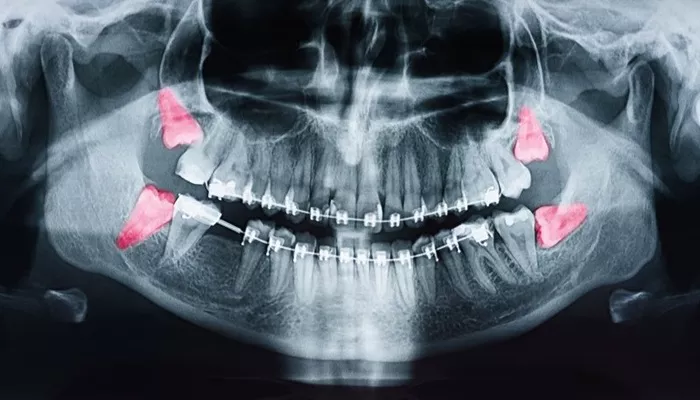Wisdom teeth, also known as third molars, are the last set of molars to emerge in the mouth, typically appearing between the ages of 17 and 25. While they were once essential for our ancestors who had a diet consisting of coarse foods, their necessity has diminished over time. Today, many individuals experience complications with these teeth, particularly impaction. Impacted wisdom teeth occur when there is insufficient space for them to emerge properly, leading to various dental issues. This article explores the detailed causes of impacted wisdom teeth.
What Causes Impacted Wisdom Teeth
1. Lack of Space in the Jaw
The most prevalent cause of impacted wisdom teeth is a lack of space in the jaw. Modern human jaws have evolved to be smaller than those of our ancestors due to changes in diet and lifestyle. As a result, there often isn’t enough room for all 32 adult teeth, including the four wisdom teeth. When there is not enough space, wisdom teeth can become trapped beneath the gum line or grow at awkward angles.
Evolutionary Changes: Over thousands of years, as human diets shifted from tough, raw foods to softer cooked foods, the size of our jaws has decreased. This evolutionary change means that while our jaws have shrunk, wisdom teeth continue to develop as they did in our ancestors when larger jaws were more common.
Crowding: Crowding occurs when existing teeth occupy most of the available space in the jaw. As wisdom teeth attempt to erupt, they may be blocked by adjacent molars or other teeth. This blockage can lead to impaction as the wisdom tooth struggles to find a path through the gum tissue.
2. Abnormal Growth Patterns
Wisdom teeth can also become impacted due to abnormal growth patterns. Instead of erupting straight up and down like other teeth, they may grow at angles or even horizontally.
Angled Eruption: Often referred to as mesial or distal impaction, this occurs when a wisdom tooth grows toward the front or back of the mouth instead of vertically. Such angled growth can lead to pressure on neighboring teeth and cause pain or discomfort.
Partial Eruption: Sometimes wisdom teeth only partially emerge through the gums. This situation can create pockets where bacteria can thrive, leading to infections and other complications such as pericoronitis (inflammation of the gum tissue surrounding a partially erupted tooth).
3. Genetics
Genetics play a significant role in determining whether an individual will experience impacted wisdom teeth.
Familial Patterns: If parents or siblings have had impacted wisdom teeth, there is a higher likelihood that an individual will also face similar issues. Genetic factors influence jaw size and tooth development patterns, which can predispose someone to impaction.
Tooth Size and Shape: Variations in tooth size and shape can also contribute to impaction. Some people may have larger wisdom teeth that require more space than others with smaller molars.
4. Gum and Bone Structure
The structure of the gums and jawbone can affect how wisdom teeth emerge.
Bone Density: A denser jawbone can make it more difficult for wisdom teeth to break through. If the bone is too thick or if there are abnormalities in bone structure, it can impede eruption.
Gum Tissue: Healthy gums are essential for proper tooth eruption. If gum tissue is inflamed or infected, it may create additional barriers for emerging wisdom teeth.
5. Age Factors
The age at which an individual experiences wisdom tooth eruption can also influence impaction.
Delayed Eruption: For some individuals, wisdom teeth may not begin to emerge until later in life due to various factors such as hormonal changes or overall health conditions. Delayed eruption increases the likelihood that there will be insufficient space available when they do attempt to come through.
Changes Over Time: As people age, their dental structure can change due to wear and tear on existing teeth, loss of bone density, or other factors that might further complicate the emergence of wisdom teeth.
6. Other Dental Issues
Existing dental problems can also contribute to impacted wisdom teeth.
Previous Extractions: If some other molars have been extracted earlier in life, this might create unexpected shifts in remaining teeth that could block the path for emerging wisdom teeth.
Misalignment: Teeth that are misaligned due to orthodontic issues may not provide a clear pathway for wisdom teeth to erupt properly.
Conclusion
Impacted wisdom teeth are a common dental issue that arises from various factors including lack of space in the jaw, abnormal growth patterns, genetic predisposition, gum and bone structure challenges, age-related changes, and existing dental problems. Understanding these causes helps individuals recognize potential symptoms early and seek professional advice before complications arise.
For those experiencing discomfort or suspecting impaction, consulting with a dental professional is crucial for evaluating their situation and determining appropriate treatment options. Regular dental check-ups can help monitor tooth development and prevent potential issues related to impacted wisdom teeth.

